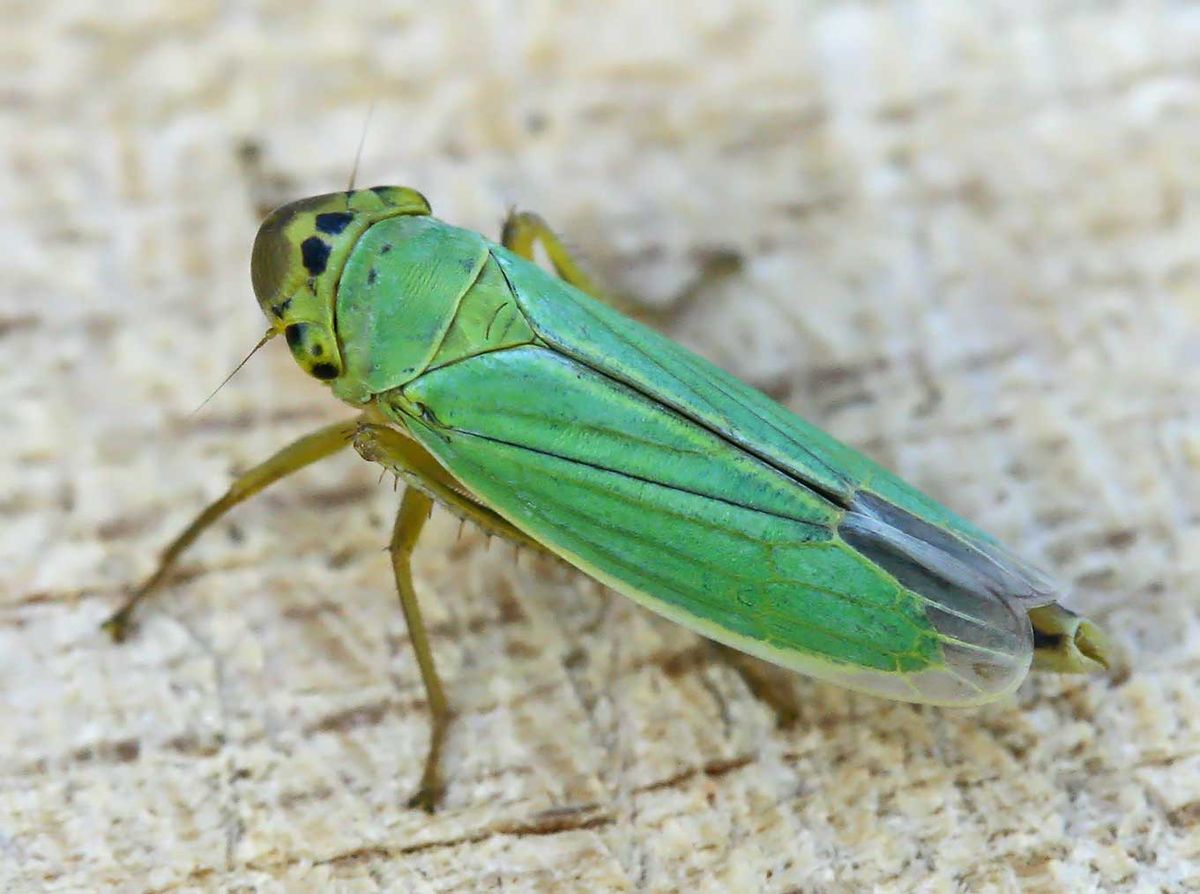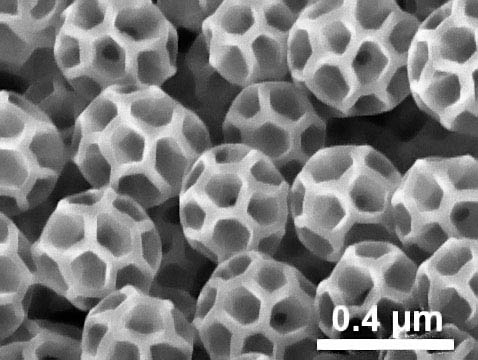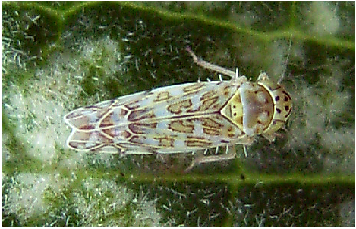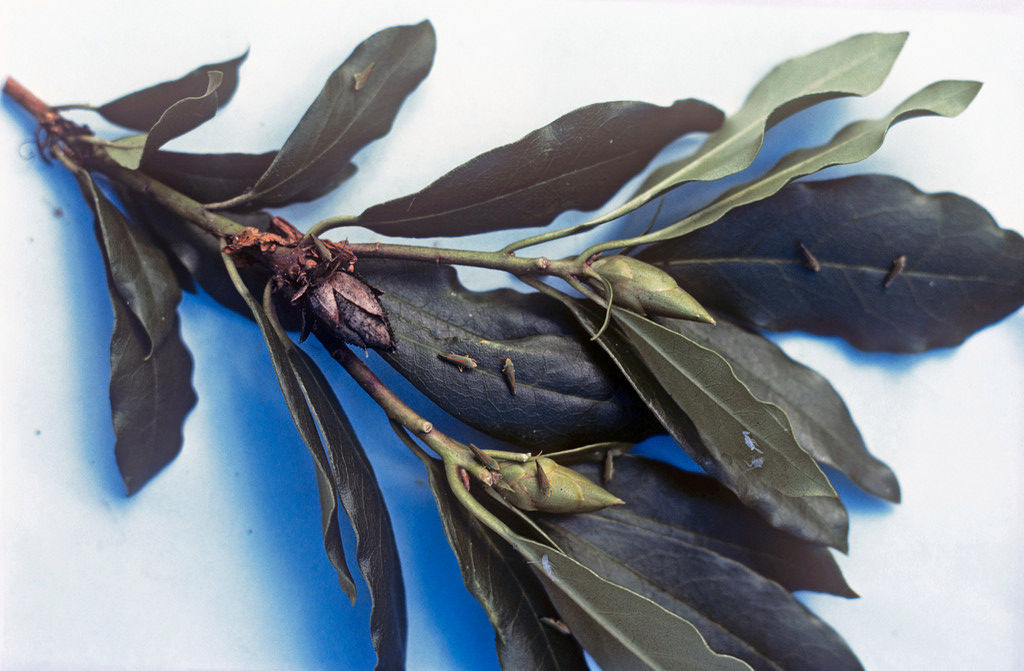- Home
- Garden Wildlife
- Insects
- Hemiptera
- Leafhoppers
Leafhoppers
Leafhoppers are sap-sucking insects in the family Cicadellidae family within the Auchenorrhyncha in the order Hemiptera. Most are 3-4mm in length but some are up to 9mm. Many are brighty coloured. The adults have relatively slender bodies that are broadest at the head end and taper towards the rear. When at rest, the wings are folded back over the insect’s body.
Species in Britain and Ireland
There are just under 300 species of leafhopper in Britain and Ireland. Some are common in gardens and a few of these can damage some cultivated plants. These include rhododendron leafhopper, Graphocephala fennahi, rose leafhopper, Edwardsiana rosae, glasshouse leafhopper, Hauptidia maroccana, and sage leafhopper, Eupteryx melissae. Jennifer Owen recorded 59 species in her Leicester garden, nearly all from light-trap catches.
Rhododendron leafhopper Green leafhopper Leafhopper nymph
Graphocephala fennahi Cicadella viridis
Biology
Leafhoppers feed by sucking sap from the underside of the foliage of plants. This usually results in a coarse pale mottled discolouration developing on the upper leaf surface. The nymphs are generally creamy white in colour and are less active than the more colourful adults. The latter readily jump off the foliage when disturbed. The cast skins of leafhopper nymphs often remain attached to the underside of leaves, unlike the cast skins of aphids that fall down and accumulate on the upper surface of leaves.
Uniquely leafhoppers produce large quantities of intricate brochosomes in their excretory tubules. These protein structures are minute, one fifteenth to a twentieth the diameter of our red blood cells. After each moult, the insects exude a liquid suspension of brochosomes and anoint their outer surface with them. The brochosomes are highly water repellent, probably also protecting the insect from its own sticky sugary excrement. Brochosomes are also used to cover their eggs, possibly protecting against egg parasitoids.
.jpg)

![Leafhopper nymph Photo: By David Short from Windsor, UK [CC BY 2.0 (https://creativecommons.org/licenses/by/2.0)]](images/Leafhopper_nymph_(5855468783).jpg)
Life cycle
Most leafhopper species have one generation a year with the overwintering stage being eggs or adult insects. The glasshouse leafhopper, which occurs on a wide range of houseplants and glasshouse plants, has several generations and can continue breeding throughout the year. Leafhopper eggs are generally inserted into the foliage of suitable host plants but those of the rhododendron leafhopper are inserted in late summer into the bud scales of next year’s flower buds. Leafhopper nymphs lack wings but are otherwise similar in appearance to the adult insects.
Role of leafhoppers in gardens
The majority of leafhoppers feed on the foliage of deciduous trees, grasses and wild flowers where any damage they cause can be tolerated. Some solitary wasps prey on leafhoppers and use them as a food store in their nests.
Some species can cause a loss of green colour from the foliage as the feeding damage builds up during the summer. Some leafhoppers have a wide range of host plants. The sage leafhopper Eupteryx melissae and Ligurian leafhopper Eupteryx decemnotata feed on many plants in the Lamiaceae plant family, including lavender, rosemary, mint, thyme, sage and Phlomis.

Scanning electron microscope image of a group of leafhopper brochosomes.
The small (3mm) glasshouse leafhopper Hauptidia maroccana can occur on some outdoor plants, especially primrose and foxglove.
The rhododendron leafhopper does not damage foliage, but its incisions cut for laying eggs in the flower buds are thought by some to provide entry points for a fungal disease known as bud blast although this remains to be proven. The bud blast fungi kill infected flower buds during the winter, and at flowering time they remain as brown unopened buds. Some leafhoppers feeding on raspberries and other cane fruits can transmit some virus diseases.
The Ligurian leafhopper has experienced a remarkable recent increase in its range. Confined to Mediterranean regions of France in 1980, it has spread to central Europe and Britain, probably assisted by trade in catmint Nepeta spp.

Other sources of information
Websites
British Bugs website
Auchenorryncha recording scheme website
RHS advice on sage and Ligurian leafhoppers
RHS advice on glasshouse leafhoppers
RHS advice on rhododendron bud blast
Books
Le Quesne, W. J. & Payne, K. R. (1985) Handbooks for the Identification of British Insects Vol 2 part 2c. Cicadellidae (Typhlocybinae) Royal Entomological Society – out of print but available as a free download from here.
Page drafted by Andrew Halstead, reviewed by Andrew Salisbury, edited by Steve Head
Bud blast on rhododendron, with leafhoppers visible

.jpg)

![Leafhopper nymph Photo: By David Short from Windsor, UK [CC BY 2.0 (https://creativecommons.org/licenses/by/2.0)]](images/Leafhopper_nymph_(5855468783).jpg)
Biology
Leafhoppers feed by sucking sap from the underside of the foliage of plants. This usually results in a coarse pale mottled discolouration developing on the upper leaf surface. The nymphs are generally creamy white in colour and are less active than the more colourful adults. The latter readily jump off the foliage when disturbed. The cast skins of leafhopper nymphs often remain attached to the underside of leaves, unlike the cast skins of aphids that fall down and accumulate on the upper surface of leaves.
Uniquely leafhoppers produce large quantities of intricate brochosomes in their excretory tubules. These protein structures are minute, one fifteenth to a twentieth the diameter of our red blood cells. After each moult, the insects exude a liquid suspension of brochosomes and anoint their outer surface with them. The brochosomes are highly water repellent, probably also protecting the insect from its own sticky sugary excrement. Brochosomes are also used to cover their eggs, possibly protecting against egg parasitoids.
Top left: Rhododendron leafhopper Graphocephala fennahi
Above:Green leafhopper Cicadella viridis Left: Leafhopper nymph
Leafhoppers
Leafhoppers are sap-sucking insects in the family Cicadellidae family within the Auchenorrhyncha in the order Hemiptera. Most are 3-4mm in length but some are up to 9mm. Many are brighty coloured. The adults have relatively slender bodies that are broadest at the head end and taper towards the rear. When at rest, the wings are folded back over the insect’s body.
Species in Britain and Ireland
There are just under 300 species of leafhopper in Britain and Ireland. Some are common in gardens and a few of these can damage some cultivated plants. These include rhododendron leafhopper, Graphocephala fennahi, rose leafhopper, Edwardsiana rosae, glasshouse leafhopper, Hauptidia maroccana, and sage leafhopper, Eupteryx melissae. Jennifer Owen recorded 59 species in her Leicester garden, nearly all from light-trap catches.

Life cycle
Most leafhopper species have one generation a year with the overwintering stage being eggs or adult insects. The glasshouse leafhopper, which occurs on a wide range of houseplants and glasshouse plants, has several generations and can continue breeding throughout the year. Leafhopper eggs are generally inserted into the foliage of suitable host plants but those of the rhododendron leafhopper are inserted in late summer into the bud scales of next year’s flower buds. Leafhopper nymphs lack wings but are otherwise similar in appearance to the adult insects.
Role of leafhoppers in gardens
The majority of leafhoppers feed on the foliage of deciduous trees, grasses and wild flowers where any damage they cause can be tolerated. Some solitary wasps prey on leafhoppers and use them as a food store in their nests.
Some species can cause a loss of green colour from the foliage as the feeding damage builds up during the summer. Some leafhoppers have a wide range of host plants. The sage leafhopper Eupteryx melissae and Ligurian leafhopper Eupteryx decemnotata feed on many plants in the Lamiaceae plant family, including lavender, rosemary, mint, thyme, sage and Phlomis.
Scanning electron microscope image of a group of leafhopper brochosomes.
The Ligurian leafhopper has experienced a remarkable recent increase in its range. Confined to Mediterranean regions of France in 1980, it has spread to central Europe and Britain, probably assisted by trade in catmint Nepeta spp.
The small (3mm) glasshouse leafhopper Hauptidia maroccana can occur on some outdoor plants, especially primrose and foxglove.
The rhododendron leafhopper does not damage foliage, but its incisions cut for laying eggs in the flower buds are thought by some to provide entry points for a fungal disease known as bud blast although this remains to be proven. The bud blast fungi kill infected flower buds during the winter, and at flowering time they remain as brown unopened buds. Some leafhoppers feeding on raspberries and other cane fruits can transmit some virus diseases.

Bud blast on rhododendron, with leafhoppers visible.
Other sources of information
Websites
British Bugs website
Auchenorryncha recording scheme website
Books
Le Quesne, W. J. & Payne, K. R. (1985) Handbooks for the Identification of British Insects Vol 2 part 2c. Cicadellidae (Typhlocybinae) Royal Entomological Society – out of print but available as a free download from here.
Page drafted by Andrew Halstead, reviewed by Andrew Salisbury, edited by Steve Head













